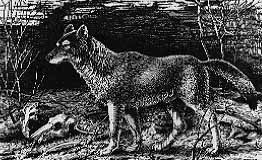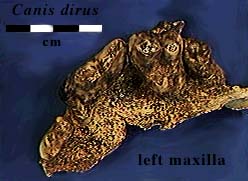Wolves, Coyotes, and Dogs (Genus Canis)

Drawing of dire wolf (Canis dirus) by Robert Larson
The genus Canis includes wolves, coyotes, jackals,
and the domestic dogs. In the midwestern U.S. at least three members of
the genus are found in sites that date from the last Ice Age. These three members are the
dire wolf (Canis dirus), the gray wolf (Canis lupus)
and the coyote (Canis latrans). One additional species, the domestic
dog (Canis familiaris), was almost certainly also present at the very
end of the Pleistocene (after about 12,000 years ago);
however, none have been recovered in Pleistocene sites from the Midwest.
The gray wolves and coyotes of the last Ice Age were probably
very similar in look and behavior to their modern relatives.
The first specimen of a dire wolf was found at near Evansville, Indiana.
The dire wolf was not quite like any animal surviving today. It was similar
in overall size and mass to a large modern gray wolf. This means it was about 1.5 meters
(5 feet) long and weighed about 50 kilograms (110 pounds) on average.
The dire wolf looked fairly similar to the modern gray wolf; however, there were
several important differences. The dire wolf had a larger, broader head and
shorter, more sturdy legs than its modern relative.

The teeth of dire wolf were much larger and more massive than those of the
gray wolf. This specimen of a dire wolf upper jaw (maxilla) was excavated
from a cave in Pulaski County, Missouri. Note the large, massive
teeth. They may have been used to crush bones. The photograph to the right is a
bottom view of a dire wolf left upper jaw

The braincase of the dire wolf was also smaller than that of a similarly-sized
gray wolf. The jaws of the dire wolf and
grey wolf also show the larger size of the dire wolf's teeth.

Many paleontologists
think that the dire wolf may have used its relatively large, massive teeth to
crush bone. This
idea is supported by the fact that dire wolf teeth frequently have
large amounts of wear on their crowns. Several people have suggested
that dire wolves may have made their living in similar ways to
modern hyenas.
Wolves and coyotes are relatively common large carnivores found
in Ice Age sites. In fact, several thousand dire wolves have been
found in the asphalt pits at Rancho La Brea in Los Angeles, California.
The coyote, gray wolf, and dire wolf have all been found in
paleontological sites in the midwestern U.S.
The fact that the lower parts of the legs of the dire wolf are proportionally
shorter than those of the gray wolf indicates that the dire wolf was probably
not as good a runner as the gray wolf.
The genus Canis underwent a mixed fate at the end of the Pleistocene.
The gray wolf and coyote survived the extinction that occurred
approximately 11,500 years ago. The dire wolf, however, was
one of the animals that did not survive. Perhaps
the dire wolf depended on scavanging the remains of
the large herbivores of the last Ice Age. The extinction of these
herbivores may have then led to the extinction of the dire wolf.
Scientists do not know if this is the case; however, they
continue to search for the
reason that many kinds
of mammals went extinct about 11,500 years ago.
Evolution of North American Canids
The evolution of the genus Canis is a complex topic
involving at least five continents. One model for the evolution
of the genus Canis would be as follows:
The genus arose in North America sometime in the Late Miocene. A
species of the genus entered Eurasia from North America via Beringia during the Late
Miocene.
Coyotes derived from an exclusively North America lineage of the
genus. This lineage is close to (or may be) C.
leophagus.
The gray wolf, jackals, and hunting dogs derived from the
Eurasian lineage. The gray wolf may have evolved from a wolf-like
species such as C. etrucus. In the Early Pleistocene the
gray wolf (Canis lupus) entered North America via
Beringia.
The domestic dog is almost certainly derived from the gray wolf.
Whether the wolf was domesticated just once or several times in
different places is still a topic of much debate. More
controversial ideas (from among others, Nowak, 1979 ) would include
the following:
The red wolf (C. rufus) is derived from a North
American lineage, perhaps from the Early Pleistocene
species C. edwardsii or may be a sister taxon to that
species.
The extinct North American dire wolf (C. dirus) evolved
from a North American lineage. Possible sister taxa of the dire
wolf include C. edwardsii, C. rufus, or the
Middle Pleistocene genus C. arbrusteri. Kurten and
Anderson, (1980) suggest that the dire wolf might be a sister taxon
to C. nehringi from the Pleistocene of South America.
More information on the evolution of the genus Canis
can be found in Kurten and
Anderson, 1980, Martin,
1989, and Nowak,
1979.
Wolf and Coyote Finds in the Midwestern U.S.

This map shows some of the sites at which dire wolves, gray wolves,
and coyotes have been found in the midwestern United States. Dire
wolf (Canis dirus) finds are shown with green dots; gray
wolf (Canis lupus) finds are shown as red squares; yellow
triangles indicate coyote (Canis latrans) finds.
The sites on this map are all relatively well-dated and
well-studied. These sites contain canid remains that are between
40,000 and 11,500 years old.




